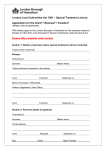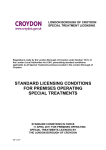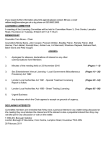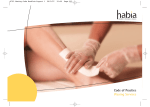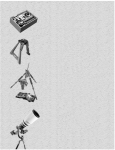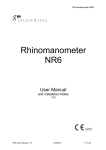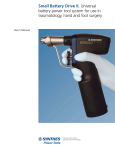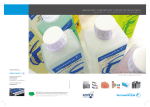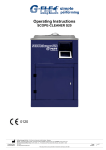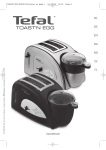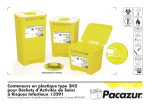Download Part 1-GENERAL - London Borough of Richmond upon Thames
Transcript
LONDON BOROUGH OF RICHMOND UPON THAMES SPECIAL TREATMENT LICENSING STANDARD LICENSING CONDITIONS FOR PREMISES OFFERING SPECIAL TREATMENTS STANDARD CONDITIONS IN FORCE 1 January 2005 FOR PREMISES OFFERING SPECIAL TREATMENTS LICENSED BY THE LONDON BOROUGH OF RICHMOND UPON THAMES st Standard Conditions For Premises Offering Special Treatments CONTENTS Introduction Notes 1 PART I – General 1) Definitions 2) Dispensation/modification of rules 1/2 2 PART II – Conditions Applicable to all Premises 1) The Licence 2) Responsibility of the Licensee 3) Charge of Licensed premises 4) Conduct of the Premises 5) People with Disabilities 6) Authorised Officers 7) Electricity 8) Personal Hygiene 9) Refuse 10) Record Keeping 11) Maintenance 12) Training 13) Anaesthetic 14) Control of Substances Hazardous to Health 15) Aftercare 3-6 3 3 4 4 4 5 5 5 5 5 6 6 6 6 6 PART III - Additional Conditions for Specific Treatments 1) Sauna 2) Heated Spa Baths 3) Floatation Tank 4) Ultra Violet Tanning Equipment 5) Tattooing 6) Electrolysis 7) Semi Permanent Make Up/Micropigmentation 8) Body Piercings 9) Artificial Nails 10) Non Surgical Lasers/IPLS 7-16 7 7 8 8 9 10 10/11 11/13 14 15/16 Appendix A – Certificates to be held at Licensed Premises 17 Appendix B – Sample Consent Form 18 Appendix C – Laser /IPLS Treatment Protocol Document Appendix D – Content Of Laser/IPLS Local Rules Document General 2004.53 19 20/22 STANDARD CONDITIONS FOR PREMISES OFFERING SPECIAL TREATMENT Revised conditions for premises licensed by the London Borough of Richmond upon Thames in force from January 1st 2005. INTRODUCTION These Standard Conditions are applicable to all premises offering special treatments. Their application does not in any way however, replace or reduce the underlying statutory duty of employers and self employed persons to comply with the requirements of the Health and Safety at Work etc Act 1974 and any associated regulations and codes of practice which may be applicable to these premises. Part 1 - GENERAL Definitions 1) In these rules, unless the context otherwise requires:- Act means Part II of the London Local Authorities Act 1991 (as amended). Approval of the Council or Consent of the Council means the written approval or consent of the Council as Licensing Authority in writing. Approved, Accepted or Permitted means approved, accepted or permitted by the Council in writing. Council means the London Borough of Richmond upon Thames. Special Treatment means massage, electric treatments, light treatments, water treatments, skin piercing and other treatments of a like kind. Establishment for Special Treatment has the meaning set out in section 4 of the London Local Authorities Act 1991 (as amended). Fire Authority means the Chief Officer and Chief Executive of the London Fire and Emergency Planning Authority. Licence Holder/Authorised Person means a person who is responsible for compliance with the standard conditions at all times that the premises are open for business. Licence means a special treatment licence granted under section 6 of the London Local Authorities Act 1991 (as amended). Premises means any premises within the Council’s area licensed for special treatments and includes all installations, fittings etc. General 2004.53 -1- Operative – the person carrying out the special treatment and, for tattooing and body piercing premises, is an approved operative as named on the licence. Authorised Officer means an Officer appointed by the Council. Dispensation or Modification of Rules 2) (a) These rules may be dispensed with or modified by the Council in any special case. (b) The Council may, in granting a licence or giving any written approval or consent under these rules, impose such terms, conditions, or restrictions as it shall specify in writing. (c) If the licensee wishes any licence terms, conditions or restrictions to be varied, an application must be made to the Council, and if the Council so requires, the application must be advertised. General 2004.53 -2- PART II - Conditions applicable to all premises 1) 2) The Licence a) The current licence or a clear copy shall at all times be prominently exhibited at the premises in a position where it can easily be read by patrons. b) The licence is personal to its holder. The licence cannot be transferred to any other person unless the procedure prescribed in the Act has been followed, and the Council has granted the application. c) The licence is only valid in respect of the premises named on the licence. d) Licences are granted for a maximum period of twelve months. e) A licence will be issued in the name of the applicant and, for the purposes specified in Condition 2(e). Responsibility of the Licence Holder/Authorised Person a) may authorise a responsible person to be in charge of the premises during opening hours. b) shall take all reasonable precautions for the safety of all persons using the premises and ensure compliance at all times with the relevant provisions of the Health and Safety at Work etc Act 1974, and other associated legislation. c) shall be in charge of the premises at all times. d) shall take out employer’s liability (where applicable) and public liability insurance cover to the minimum value of £2,000,000 e) shall ensure that all operatives carrying out ‘special treatments’ are suitably trained/qualified and evidence of such shall be submitted to the Council for approval. f) For tattooing and body piercing premises the Council shall list the names of all operatives on the licence following their approval. Trainee/Apprentices shall appear on the licence named as such. No other persons other than those named on the licence are permitted to carry out body piercings or tattooing. g) shall ensure that no nuisance arises from the business, e.g. odours, noise etc. h) shall ensure that at least one operative present in the premises on a day to day basis carrying out special treatments is required to have an General 2004.53 -3- understanding of spoken and written English in order to satisfactorily discuss client records and aftercare advice. 3) i) shall be responsible for maintaining a fire risk assessment to include proper precautions against fire, the maintenance and proper order of means of escape in case of fire, and the means of fighting fire at the premises. j) shall clearly display a tariff of all special treatments provided. k) Suitable heating, lighting and ventilation are required in all areas of the premises and this shall be maintained in a suitable and safe conditions. l) An accessible wash hand basin shall be fitted within the treatment area and provided with hot and cold running water, preferably by mixer taps and non-hand operated taps. Sanitising soap dispensary and disposable paper towels shall provided. m) A suitable equipped first aid kit shall be readily accessible at the premises. n) Supply of drinking water shall be provided for public use, close to the treatment areas. Charge of Licensed Premises a) 4) 5) The licence holder/authorised person shall be familiar with all the conditions contained in this document and take responsibility for any breaches of said conditions. Conduct of the Premises a) No poster, advertisement etc shall be displayed which is unsuitable for general exhibition. b) The licence holder/authorised person shall ensure that no part of the premises is used by persons, for soliciting or other immoral purposes. People with Disabilities It is the policy of the Council that access for disabled people should be provided at business premises licensed for special treatment. Licensees are, therefore strongly encouraged to provide such facilities so as to enable the admission of disabled people and are reminded of the duties imposed by the Disability Discrimination Act 1995. General 2004.53 -4- 6) Authorised Officers Authorised officers, on presentation of their written authorisations and proof of identity shall be admitted at all reasonable times to all parts of the premises. 7) 8) Electricity a) The licensee shall ensure that all portable electrical appliances used within the licensed premises are maintained regularly in accordance with the Electricity at Work Regulations 1989. Records of this maintenance must be available at the premises at the time of the inspection or must be forwarded to the Council. b) The licensee shall ensure that the fixed electrical installation is inspected by a competent electrical engineer in accordance with the Electricity at Work Regulations 1989 and a copy of the current certificate is available at the premises at the time of the inspection or must be forwarded to the Council. Personal Hygiene Any person carrying out any special treatment must ensure that: 9) a) any open boil, sore, cut or other open wound is effectively covered by an impermeable dressing. b) hands are kept clean and are washed immediately prior to carrying out any treatment. c) they refrain from consuming food and drink during the course of the treatment. Refuse Under the Controlled Waste Regulations 1992 and the Environmental Protection Act 1990 operatives/licence holders have a duty of care to ensure that all clinical waste i.e. used dressings, swabs etc (infected or not) and used needles are collected and disposed of by a licensed contractor. A waste transfer document shall be available at the premises for inspection. The clinical waste bags shall be yellow and marked as ‘Biohazard – clinical waste’ and whilst awaiting collection should be stored in a secure area. 10) Record Keeping Records including name, address, age, date & type of treatment received shall be kept for all treatments, for a period of at least 3 years. General 2004.53 -5- Any contra–indications e.g. Heart conditions, diabetes, epilepsy etc for each treatment will be discussed with the client prior to any treatment, and the client shall sign a record card to say that they have been made aware of the risks involved. 11) Maintenance All systems i.e. fire safety equipment, boilers; etc provided in the premises shall be maintained/serviced regularly by competent persons and records available on site for inspection. All equipment used in connection with special treatments shall be serviced/ maintained in accordance with the manufacturers/suppliers recommendation, and records kept. Bench top sterilisers shall be calibrated and maintained in accordance with the Manufacturers recommendations and records available on site. 12) Training All persons carrying out special treatments shall have received suitable training in the treatments being undertaken and also use of any relevant equipment. Written evidence of all training shall be available on the premises for inspection. 13) Anaesthetic Administration of local anaesthetic injections other than by medically qualified practitioners is an offence. Under the Medicines Act 1968, local anaesthetic creams, sprays, gels etc. are prescription only medicines and pharmacy medicines which may only be sold by pharmacists for medical application on the patient only. Their use prior to a body piercing is therefore an offence. 14) Control of Substances Hazardous to Health Regulations 2002 Substances which fall under the above Regulations e.g. Barbicide, bleach, nail monomers etc shall be assessed in accordance with the requirements of those Regulations and all the necessary precautions taken to ensure their safe use and storage. 15) Aftercare Each client shall be provided with written aftercare advice for each treatment they receive, and confirmation of this should be recorded on their client record card. General 2004.53 -6- PART III - Additional conditions for specific treatments 1) 2) Sauna a) A thermometer shall be provided indicating the temperature inside the sauna. b) An emergency button shall be provided on the sauna, which is connected to a reception or other staffed area. c) A clock or timer shall be visible to users, from inside the sauna. d) The temperature control device shall not be accessible to users of the sauna. e) The hot coals in the sauna shall be protected by a guard rail or barrier. f) Shower facilities shall be provided close to the sauna. g) A supply of fresh drinking water shall be available close to the sauna. h) Safety guidelines on the use of the sauna shall be displayed nearby. Heated Spa Baths a) Children under 15 are prohibited from a spa bath. b) The spa water shall be suitably treated to prevent the growth of legionella bacteria by means of automatic dosing equipment in accordance with the Approved Code of Practice L8 entitled ‘Control of Legionella Bacteria in Water Systems’ produced by the Health and Safety Executive. c) Water tests shall be carried out at 4 hourly intervals to ascertain the chlorine, pH etc levels of the water. Written records of the results shall be kept on the premises. d) The spa shall be fitted with an automatic close down device, which operates approx every 15 minutes for a period of 5 minutes. e) Safety guidelines on the use of the spa shall be displayed nearby. f) An emergency button shall be provided on the spa, which is connected to a reception or other staffed area. g) Shower facilities shall be provided close to the spa. h) A supply of fresh drinking water shall be available close to the spa. General 2004.53 -7- 3) 4) Floatation Tank a) Shower facilities shall be provided close by the equipment. b) A supply of fresh drinking water shall be provided near to the equipment. c) The water shall be filtered and purified between clients. Ultra Violet Tanning Equipment a) No persons under the age of 16 shall be permitted to use tanning equipment. b) Prior to the use of tanning equipment a record card shall be completed & signed by the user to acknowledge that they have been made aware of and understand the contra-indications associated with ultra violet radiation, particularly with regard to drugs and medical conditions. A record of the frequency of visits shall also be recorded. c) The length of time that a client uses the tanning equipment shall be controlled by the management and based on the user type of skin, power of the sunbed, and age of the tubes etc. d) Users of tanning equipment shall have access to an emergency assistance device, which is connected to the reception area. e) Each tanning unit shall be fitted with an emergency stop button, which is connected to a reception or other staffed area. f) All users shall be provided with protective eye equipment free of charge. g) Arrangements shall be made to ensure that the tanning equipment is cleaned between clients. h) HSE guidelines IND (G) 209 on UV tanning shall be displayed in each tanning cubicle, copies of this document can be obtained from HSE Website i) Regular maintenance shall be carried out, to include replacement of tubes. Records of all maintenance visits shall be available at the premises at all times. j) The HSE recommend a maximum of 20 ultra violet tanning sessions per year, clients shall be advised when they have reached this number and made aware of this recommendation. If the client still wishes to continue with further exposure then their written consent shall be recorded on their client record card. General 2004.53 -8- 5) Tattooing a) No tattoo shall be carried out on a client who has not reached their 18th Birthday in accordance with the Tattooing of Minors Act 1969. b) A tattoo may only be performed by an approved person who is named on the licence, in accordance with Part II 2 (e) of these conditions. c) All walls, floors, surfaces, seating etc shall be made of washable material. d) Prior to treatment every client shall read and sign a consent form, which contains details of medical history, name, address, age etc. Photographic proof of age may be requested and details should be entered onto the consent form. e) An example of consent form is attached in Appendix B. These forms shall be kept on the licensed premises for a period of at least 3 years, and be available for inspection at all times. f) Under the Controlled Waste Regulations 1992 and the Environmental Protection Act 1990 operatives/licence holders have a duty of care to ensure that all clinical waste i.e. used dressings, swabs etc (infected or not) and used needles are collected and disposed of by a licensed contractor. A waste transfer document shall be available at the premises for inspection. The clinical waste bags shall be yellow and marked as ‘Biohazard – clinical waste’ and whilst awaiting collection should be stored in a secure area. g) Sharps containers shall comply with the British Standard BS7320 and UN3291 and carry the ‘kitemark’. Sharps containers should be sited above floor level and below shoulder level. h) An accessible wash hand basin should be fitted within the operating area provided with hot and cold running water, preferably by mixer taps. Liquid soap and a paper towel dispenser should also be fitted in this area. i) In addition to the wash hand basin, a deep sink with hot and cold running water should be provided exclusively for washing used equipment, this should be fitted in a separate ‘dirty’ area away from the clean operating area. j) Used instruments should be manually cleaned in the sink before undergoing the ultrasonic process, cleaning should occur below water level rather than under running water. Staff should wear suitable aprons etc during this process if there is a risk of splashing. k) Following the manual cleaning the instruments should be put through a cycle in the ultrasonic cleaner; the lid should remain closed whilst the machine is in operation. Items should be rinsed thoroughly on General 2004.53 -9- completion of the cycle. The detergent solution should be renewed at least weekly. 6) l) Instruments should then be sterilised in a bench top autoclave; if using a non-vacuum type then the instruments should be placed UNWRAPPED in the autoclave. On completion of the cycle the instruments should be placed in an airtight plastic container and if not used within 3 hours they must be re-sterilised. m) If a vacuum type autoclave is used then instruments should be wrapped/pouched prior to sterilisation. A drying cycle is required to ensure that the pouches etc are not left in a damp condition. The pouches remain sterile for up to 6 months. n) Autoclaves should be run daily on a test cycle to ensure the machine is working correctly, door seals etc should be checked weekly. The autoclave should be maintained/serviced in accordance with the manufacturer’s recommendations and written evidence should be available on site. o) Needles, pigment caps, razors and wooden spatulas are single use only and must be disposed of as clinical waste after use. p) Any jewellery, which contains more than 0.05% nickel shall not be used, as this may cause an allergic reaction. q) A written aftercare leaflet shall be given to each client in accordance with general condition 15. Electrolysis a) 7) Individual pre-wrapped sterilised needles shall be used and disposed of as clinical waste after each client. Semi-permanent make up/micropigmentaion a) A consultation with the client shall take place prior to the treatment, during which time a patch test shall be carried out for adverse reactions to the pigments intended to be used, and any contra – indications discussed. b) Disposable gloves should be worn throughout the procedure these should be non-powdered nitrile or vinyl. They should be disposed of as clinical waste. c) Under the Controlled Waste Regulations 1992 and the Environmental Protection Act 1990 operatives/licence holders have a duty of care to ensure that all clinical waste i.e. used dressings, swabs etc (infected or not) and used needles are collected and disposed of by a licensed contractor. A waste transfer document shall be available at the premises for inspection. General 2004.53 - 10 - d) The clinical waste bags shall be yellow and marked as ‘Biohazard – clinical waste’ and whilst awaiting collection should be stored in a secure area. e) Sharps containers shall comply with the British Standard BS7320 and UN3291 and carry the ‘kitemark’. Sharps containers should be sited above floor level and below shoulder level. f) Needles and other component parts should where possible be the single use disposable type. These must be disposed of as clinical waste. g) Re usable instruments should be manually cleaned in the sink before undergoing the ultrasonic process, cleaning should occur below water level rather than under running water. Staff should wear suitable aprons etc during this process if there is a risk of splashing. • Following the manual cleaning the instruments should be put through a cycle in an ultrasonic cleaner, the lid should remain closed whilst the machine is in operation. Items should be rinsed thoroughly on completion of the cycle. The detergent solution should be renewed regularly. h) Instruments should then be sterilised in a bench top autoclave, if using a non-vacuum type then the instruments should be placed UNWRAPPED in the autoclave. On completion of the cycle the instruments should be placed in an airtight plastic container and if not used within 3 hours they must be resterilised. If a vacuum type autoclave is used then instruments should be wrapped/pouched prior to sterilisation. A drying cycle is required to ensure that the pouches etc are not left in a damp condition. The pouches remain sterile for up to 6 months. 8) i) Autoclaves should be run daily on a test cycle to ensure the machine is working correctly, door seals etc should be checked weekly. The autoclave should be maintained/serviced in accordance with the manufacturer’s recommendations and written evidence should be available on site. j) A written aftercare leaflet shall be given to each client. Body Piercing a) A piercing may only be performed by an approved operative who is named on the licence. b) Piercings with the exception of nipple and genital may be carried out with written parental consent under the age of 16. c) Piercings with the exception of the genitals may be carried out on 1618 year olds with either parental consent or a valid photographic identification e.g. passport or driving licence. General 2004.53 - 11 - d) Any piercing may be carried out on anyone over 18 years of age with a valid photographic identification e.g. passport or driving licence. e) Prior to treatment every client or parent/guardian shall read and sign a consent form, which contains details of name, address, age etc. These records shall be kept for at least 3 years and be available for inspection at the premises. A specimen consent form is attached as Appendix B. f) Single use disposable gloves should be non-powdered and made from nitrile of vinyl must be worn during the procedure. These must be disposed of as clinical waste in accordance with general condition 9. g) The following guns are approved for ear piercing, Inverness, Coren, Caress, Caflon, Studex, Tripps and Poly Dots Cassette. h) The following guns are approved for nose piercing, Studex. i) Jewellery fitted with a stud shall not be used in nose piercing. j) A written aftercare leaflet for all piercings shall be given to each client. k) It is recommended that operatives are immunised against Hepatitis B. l) It is recommended that operatives hold a valid first aid certificate. m) Administration of local anaesthetic injections other than by medically qualified practitioners is an offence. n) Under the Medicines Act 1968, local anaesthetic creams, sprays, gels etc. are prescription only medicines and pharmacy medicines which may only be sold by pharmacists for medical application on the patient only. Their use prior to a body piercing is therefore an offence. o) All walls, floors, surfaces, seating etc shall be made of washable material. p) Under the Controlled Waste Regulations 1992 and the Environmental Protection Act 1990 operatives/licence holders have a duty of care to ensure that all clinical waste i.e. used dressings, swabs etc (infected or not) and used needles are collected and disposed of by a licensed contractor a waste transfer document shall be available for inspection. q) The bags shall be yellow and marked as ‘Biohazard – clinical waste’ and whilst awaiting collection should be stored in a secure area. r) Sharps containers shall comply with the British Standard BS7320 and UN3291 and carry the ‘kitemark’. Sharps containers should be sited above floor level and below shoulder level. s) An accessible wash hand basin should be fitted within the operating area provided with hot and cold running water, preferably by mixer taps. Liquid soap and a paper towel dispenser should also be fitted in this area. General 2004.53 - 12 - t) In addition to the wash hand basin, a deep sink with hot and cold running water should be provided exclusively for washing used equipment, this should be fitted in a separate ‘dirty’ area away from the clean operating area. u) Used instruments should be manually cleaned in the sink before undergoing the ultrasonic process, cleaning should occur below water level rather than under running water. Staff should wear suitable aprons etc during this process if there is a risk of splashing. v) Following the manual washing, the instruments should be put through a cycle in the ultrasonic cleaner; the lid should remain closed whilst the machine is in operation. Items should be rinsed thoroughly on completion of the cycle. The detergent solution should be renewed at least weekly. w) Instruments should then be sterilised in a bench top autoclave, if using a non vacuum type then the instruments should be placed UNWRAPPED in the autoclave. On completion of the cycle the instruments should be placed in an airtight plastic container and if not used within 3 hours they must be re-sterilised. If a vacuum type autoclave is used then instruments should be wrapped/pouched prior to sterilisation. A drying cycle is required to ensure that the pouches etc are not left in a damp condition. The pouches remain sterile for up to 6 months. x) Autoclaves should be run daily on a test cycle to ensure the machine is working correctly, door seals etc should be checked weekly. The autoclave should be maintained/serviced in accordance with the manufacturer’s recommendations and written evidence should be available on site. y) Needles, gloves etc are single use only and must be disposed of as clinical waste after use. z) Any jewellery which contains more than 0.05% nickel shall not be used, as this may cause an allergic reaction. aa) All jewellery shall be sterilised in the autoclave prior to use in the piercing. General 2004.53 - 13 - 9) Artificial Nails a) Written records containing clients name, address, telephone number, date of treatments and operatives name shall be kept for each client. These shall be kept for a period of at least 3 years and be available at the premises for inspection. b) The condition of the client’s nails should be examined prior to any treatment and if there is any presence or suspicion of any infection etc they should be referred for medical treatment. c) All operatives shall be qualified to Level 3 Unit 19 NVQ standard or an acceptable equivalent which is approved by the Council. Copies of qualifications shall be available for inspection at the premises. d) An assessment shall be carried out of all products used in connection with the treatment e.g. Acetone, Ethyl Methacrylate etc under the Control of Substances Hazardous to Health Regulations 2002. Copies of safety data sheets for all products used shall be available on the premises. e) Products containing Methyl Methacrylate (MME) are subject to an occupational exposure limit and research has shown that regular exposure to them can cause respiratory etc sensitisation. The use of a suitable alternative product should be considered e.g. Ethyl Methacrylate (EMA). f) All products used in the premises should be stored in suitably labelled containers, specifying details of contents, supplier etc. g) Floor coverings shall be made of impervious material which can be easily cleaned. h) Any cotton wool etc which has come into contact with nail liquids should be disposed of in suitably covered receptacles. i) Dispensed nail liquids shall be kept in covered containers at all times when not in use. j) Electric drills may only be used by suitably trained operatives, written evidence of training should be available on site. k) Drill bits etc shall be cleaned between use on each client. General 2004.53 - 14 - 10) Non Surgical Lasers/IPLS a) The licence holder shall employ the services of an Expert Medical Practitioner to produce the ‘treatment protocol’ document which shall be kept on site. (Appendix C outlines the information required in this document) b) The Licence holder shall employ the services of a certificated Laser Protection Advisor who will assist in the production of the ‘local rules’ document (A specimen laser local rules document is attached as Appendix D). The ‘local rules ‘ shall be updated if there are any changes made to the equipment in use, changes in procedure or treatment room if these affect the safe use of the laser/IPL. c) All authorised users of laser/IPLS shall be trained to at least the Core of Knowledge Certificate level and records of such training shall be kept on site with the local rules. Any training on the specific equipment in use at the premises shall also be recorded. Such training should be refreshed every 3-5 years. d) A suitably qualified member of staff on the premises shall be identified as the laser protection supervisor they will have day to day to responsibility of ensuring the local rules are followed. e) A treatment register shall be completed every time the laser/IPLS is operated, including the following information: • • • • • • the name of the person treated (including a second means of identification); the date and time of treatment; the name and signature of the laser/IPLS operator; the nature of the laser/IPLS treatment given the treatment parameters any accidents or adverse effects. Laser/IPL Controlled Area f) The area around working lasers/IPLS shall be controlled to protect other persons while treatment is in progress. The controlled area shall be clearly defined and not used for other purposes. A suitable safety warning sign or light entry system which complies with current British Standards shall be in place on the door of the controlled area. g) All lasers/IPLS shall comply with current standards (BS EN 606012-22 for medical lasers and BS 60601-2-57 and shall display labels identifying them, their wavelength or range of wavelengths and the maximum output power of the radiation emitted. The labels shall be clearly visible on the front or side of the machine. General 2004.53 - 15 - h) The door to the controlled area shall be fitted with a suitable device which can be operated from the outside in an emergency i) Any windows in the controlled area shall be fitted with opaque blinds approved by the LPA . i) The controlled areas shall be kept clear of clutter, mirrors shall be avoided and jewellery shall not be worn. k) Surfaces within the controlled area shall be of a matt or eggshell Finish. l) Protective eyewear shall be worn by everyone within the controlled area whenever there is a risk of exposure to laser/IPLS . All protective eyewear shall be marked with the wavelength range and protection offered as detailed in the local rules document. They shall be in a clean serviceable condition. m) The laser protection supervisor shall ensure that the key to any laser/IPLS equipment is kept in a secure and separate area when not in use and that only authorised users have access to the key. n) Lasers/IPLS shall be serviced annually and a record kept of servicing and repairs with the local rules document. General 2004.53 - 16 - APPENDIX A CERTIFICATION REQUIRED TO BE AVAILABLE AT THE LICENSED PREMISES 1) Electricity • 2) Sterilisers • 3) 4) • All applicants and licence holders shall hold a copy of the licence of the contractor who is removing the controlled waste. • Copies of transfer documents for the removal of controlled waste should also be held. Insurance A copy of the employers liability (where applicable) and public liability certificates should be available for inspection. Training • 6) All applicants and licence holders are required to hold valid documentation confirming the safety/calibration of all sterilisers which are used in connection with the business e.g. autoclaves, ultrasonic cleaners, ultra violet cabinets etc. All works must be carried out by a competent engineer. Controlled Waste • 5) All applicants and licence holders are required to hold valid documentation confirming the safety of the fixed wiring throughout the premises. All works must be carried out by a competent electrical engineer in accordance with the Electricity at Work Regulations 1989. e.g. NICEIC ‘Periodic Inspection Report For An Electrical Installation’. All certificates of qualification relevant to the licensed treatments shall be available for inspection. Fire Risk Assessment Where the Regulatory Reform (Fire Safety) Order 2005 applies to your premises you must carry out a FIRE RISK ASSESSMENT and make an EMERGENCY PLAN. General 2004.53 - 17 - APPENDIX B CONSENT FORM (Name & Address of premises) I hereby declare that I give (piercer /tattoo artists name) my full consent to (pierce / tattoo) me and that the information given below is true to the best of my knowledge. I have /suffer from the following: Heart Condition /Pacemaker Epilepsy Haemophilia HIV/Hepatitis High Blood Pressure Diabetes Skin condition e.g. Psoriasis Allergies i.e. plasters Taking blood thinning medication e.g. aspirin NO/YES NO/YES NO/YES NO/YES NO/YES NO/YES NO/YES NO/YES NO/YES I understand that no form of anaesthetic will be used in the procedure. I understand that every care will be taken to ensure that the procedure is carried out in a hygienic way, which includes the use of disposable or pre-sterilised equipment. I will follow the verbal and written aftercare instructions which have been given to me. I AM NOT UNDER THE INFLUENCE OF ALCOHOL OR DRUGS I HAVE REQUESTED THIS PIERCING / TATTOO OF MY OWN FREE WILL Print Full Name……………………………………………………………………………….. Address ……………………………………………………………………………………….. ………………………………………………………………………………………………….. AGE ……………. Date of Birth…………………….. Type of ID ……………………… Signature of client …………….……….. …Guardian if under 16 ……………………….. Date……………….…….. Tattoo/piercing site …………………………………………. ………………………………………………………………………………………………….. General 2004.53 - 18 - APPENDIX C Laser /IPLS Treatment Protocol Document A treatment protocol must be produced by an expert medical practitioner (EMP) in relation to the licence holders equipment/premises. The treatment protocol sets out the necessary pre-treatment checks and tests, the manner in which the laser/IPLS is to be applied, the acceptable variations in the settings used, and when to abort a treatment. The treatment protocol should be signed and dated by the EMP to confirm authorisation, should be reviewed annually and include a projected date for review. A separate treatment protocol should be in place for each laser/IPLS in use at the licensed premises. The treatment protocol must include the following: • • • • • • • • • • • • name and technical specifications of the equipment contraindications treatment technique – general treatment technique – hair reduction client consent prior to treatment cleanliness and infection control pre-treatment tests post-treatment care recognition of treatment-related problems emergency procedures permitted variation on machine variables procedure in the event of equipment failure General 2004.53 - 19 - APPENDIX D CONTENT OF LASER/IPLS LOCAL RULES DOCUMENT 1) Potential Hazards List all types of hazards including fire, skin and eye injuries, electrical etc 2) Device Description Description of all devices including output, serial numbers etc.. 3) Treatment Protocol Reference to separate document produced by the Expert Medical Practitioner. 4) Written Procedures Supported by reference to user manual/training manual etc 5)Adverse Incident Procedure a) Details of actions that shall be taken in cases of emergency e.g. eye exposure b) Name, address and telephone number of local accident and emergency department. c) Any incidents must also be reported to Richmond Council, list of their contact details, 6) Emergency Shutdown Procedure Instructions as set down in manufacturer’s manual or treatment protocol. 7) Register of Authorised Users Details of trained personnel with signed declarations of individuals. 8) Laser Protection Advisor Contact details of the LPA 9) Laser Protection Supervisor a) One Authorised User shall be nominated Laser Protection Supervisor to ensure that the register is maintained and the local rules are adhered to b) Name of the laser protection supervisor 10) Record of laser use General 2004.53 - 20 - A register shall be kept which will separately record the following information every time the IPL is operated The name and date of birth of the person treated date of treatment the operator the treatment given any accident or adverse effects. 11) Laser/IPL Operator Training a)All laser/IPL ‘authorised users’ shall hold the Core of Knowledge Training Certificate together with specific training on the use of on site equipment provided by the supplier of the Laser/IPLS. b) Details of all training shall be recorded in the Register of Authorised Users or a separate Training Register. 12) Controlled Area designation and access a) The room in which the laser/IPLS is used shall be designated a ‘Controlled Area’ and the laser shall only be used in this area. Approved warning signs shall be fitted to the door i.e. ‘Controlled Area’, ‘Eye Protection’ etc b). A notice should be fixed to the laser/IPLS indicating that its use is subject to the Local rules. 13) Register of Authorised Users A register shall be kept of personnel authorised to operate the equipment. 14) Safe Operation of device a) No more than one laser/IPL shall be switched on during the client treatment. b). When the laser/IPL is in operation the number of persons in the room shall be kept to a minimum. c) The laser/IPL shall not be enabled to fire unless it is directed towards the treatment site or a beam stop. d) The Authorised User shall be careful to avoid reflections of the beam from Instruments/equipment in close proximity to the beam path, Matt/non reflective surfaces etc shall be provided. e). Whenever the device is unattended by an Authorised User, the laser shall be switched off and the key withdrawn and placed in safe custody by the Authorised User. 15) Operator responsibility a) It is the responsibility of the equipment Authorised User to be aware of the General 2004.53 - 21 - nature of the hazard involved and to be familiar with the manufacturer’s operating instructions. b) During the operation of the laser (or IPL) the Authorised User is responsible for the safety of all persons present, including the client and themselves. 16) Protective eyewear Protective eyewear shall be provided and clearly marked for the laser. It is important that the correct goggles are used e.g. the use of a coloured sticker or other identifier on the goggles matches a similar identifier on the laser of IPL. The Authorised User shall instruct all personnel in the Controlled Area to wear goggles suitable for the laser being used. 17) Application of local rules a). The laser shall only be used in accordance with these local rules. b). Authorised Persons shall sign statements that they have read and understood these local rules. c) The local rules shall be kept in the treatment room/s at all times. General 2004.53 - 22 -
























